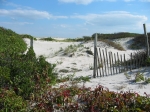The Physical Environment
SAND DUNES
Beach dunes are formed by sand that is blown to the back edge of the beach. The winds that blow off the ocean bounce sand grains along the ground and also carry them through the air. Vegetation, driftwood, or any object - including a dune – can intercept and stop sand that is being bounced along the ground. Obstructions also slow the wind and cause airborne sand to drop down to the ground. Wind blown sand therefore accumulates around any structures that are found on the beach.
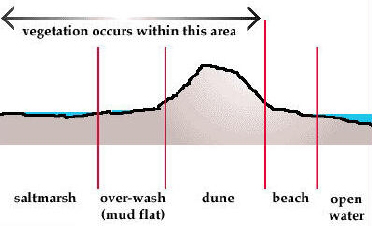
USGS drawing
Dune building is a gradual process and plants play an important role in dune formation. Roots stabilize the dune and above ground plant structures intercept and trap more sand. Dunes can form without plants but they will be smaller than the potential size they could reach if plants were able to establish and grow. If you take away the plants from a well developed dune, it becomes less stable and is likely to decrease in size. In Island Beach State Park you will see signs that say do not walk on the dunes. This protects the plants from being crushed and killed, which in turn helps the dune remain stable.
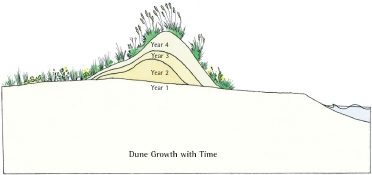
This drawing illustrates the annual growth of a dune over 4 years time (from 'The Dune Book' - Sea Grant of North Carolina).
In Island Beach State Park there are a number of dunes that extend back from the beach towards the bay. The dune closest to the ocean is the primary dune, or foredune, followed by what are called secondary dunes or back dunes. The dune crest of the primary dune often is parallel with the ocean shoreline. The secondary dunes become less uniform as they weather and age. Their crests are less apt to be as neatly aligned with the shoreline.

US Air Force drawing
A series of dunes develop through dune migration. This occurs when the beach remains stable for an extended period of time and the fore dune is able to continually grow without losing any sand to beach erosion. A shifting sand dune can eventually move far enough away from the ocean shoreline that a new dune will begin forming in front of the older dune.

There are two natural activities that take sand away from beach dunes. Naturally occurring beach erosion, caused by storms, hurricanes, and strong high-tides, can draw large amounts of sand into the sea over a short period of time. Dunes act as a sand reservoir that can replenish eroded beach material. When erosion is really severe it can even remove sand directly from the dune. A dune will begin rebuilding once the effects of the erosion event have stabilized.
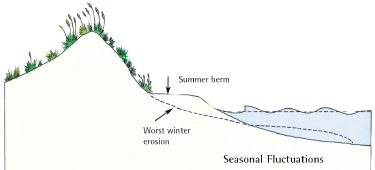
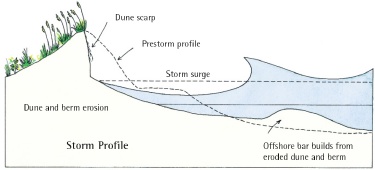
A diagramatic representation of dune erosion. The upper diagram represents natural seasonal changes in the beach. The dune is not effected by these changes as long as there are not large differences in the summer to winter beach profiles. The lower diagram illustrates a storm surge erosion event that has taken sand from the beach and the dune. The sand in the newly formed offshore sand bar can gradually be brought back up to the beach through constructive wave action. (drawing from 'The Dune Book' - Sea Grant of North Carolina)
Dune systems that have been degraded or destroyed by human activities are often not able to rebuild themselves. Erosion can then become very damaging because sand taken away by each storm is not easily replenished by natural processes.
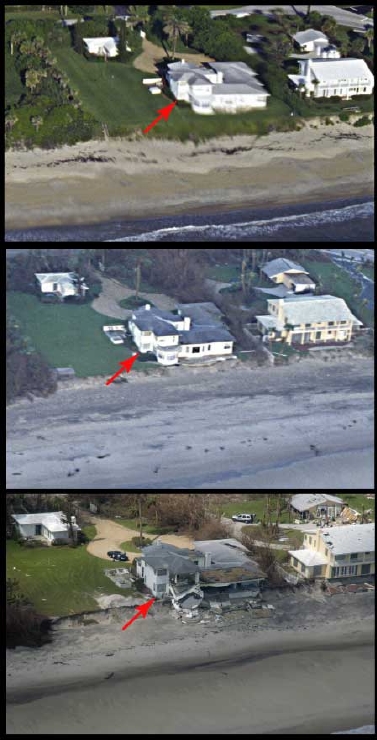
Dune eroded and house undermined, Vero Beach, FL: Vero Beach, FL (upper photo: 8/12/97; middle: post-Frances, 9/8/04; bottom: post-Jeanne, 9/29/04): At the time of the first photo, the seaward face of the dune was vegetated. After Hurricane Frances, the dune had retreated to the edge of the house. During Jeanne, the dune eroded farther and undermined the house. (photos and caption from U.S. Geological Survey).
A second process that moves sand away from a dune is a blowout. This is a gap in the primary dune that can be formed by water breaching a primary dune or by strong winds. Once a gap is created, wind that normally is forced up and over the dune is now funneled through the gap. This increases the wind speed in that area and causes the gap to increase in size. This process transports sand behind the primary dune. Gaps also create opportunities for seawater to innundate areas behind the primary dune during very high tides or storm surges.
Learn more about barrier islands at Geology News.
